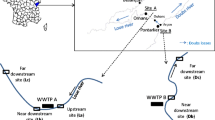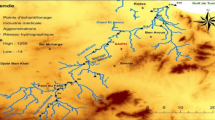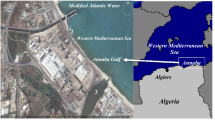Abstract
N-alkanes were measured both in dissolved and particulate-adsorbed phases of water samples collected from five stations located along Shatt al-Arab River in Iraq. The aim of this study was to provide a background information on the presence, origin, and distribution of n-alkanes in the waters of Shatt al-Arab River. Total concentrations of n-alkanes were lower in the dissolved phase (29.37 (μg L−1) than in the particulate-adsorbed fraction (17.62 μg g−1 dw). Distribution of n-alkanes in both fractions is characterized by two distinct patterns. First, for C compounds numbered C14 to C22, the ‘odd’ numbered hydrocarbons were slightly more abundant with C17 being the most concentrated. The second is shown within n-alkanes greater than C22. In these the ‘odd’ numbered hydrocarbons show even greater predominance indicating that much of the n-alkanes in the waters of Shatt al-Arab, may have originated from aquatic biogenic sources; i.e., diatoms, algal forms, bacterial activities, and higher plants. The CPI values were found to be from 0.99 to 1.98 in the dissolved fraction and from 0.70 to 2.10 in the particulate fraction. Petroleum hydrocarbon inputs and urban related oil discharges (anthropogenic pollution) may also have contributed to the input of n-alkanes in Shatt al-Arab, particularly near the city of Basrah (St. IV). Total concentrations at station IV were much higher (8.40 μg L−1 and 5.80 μg g−1) than that for the most upstream station, # I, (3.20 μg L−1 and 1.48 μg g−1) and decreased again further downstream at station V (7.10 μg L−1 and 4.32 μg g−1). The CPI values were around 1.0 in station IV. In a conclusion, results obtained in this study indicate that the n-alkanes in the waters of Shatt al-Arab River are of aquatic biogenic and anthropogenic (petroleum related) origins.
Similar content being viewed by others
References
Al-Saad, H. T.: 1983, ‘Baseline Study of Petroleum Hydrocarbons in Shatt Al-Arab River’, MSc Thesis, University of Basrah.
Al-Saad, H. T. and Bedair, H. M.: 1989, Mar. Mesopotamia 4, 117.
Al-Saboonchi, A. M. and Al-Saad, H. T.: 1988, ‘Check List of Algae from Shatt Al-Arab River, Iraq’, J. Univ. Kuwait Sci. 15, 79.
Caldicott, A. B. and Eglinton, G.: 1973, ‘Surface Waxes’, in: L. P. Miller (ed.), Phytochemistry III-Inorganic Elements and Special Groups of Chemicals, Van Nostrand Reinhold, New York, N.Y., pp. 162–164.
Cauwet, G.: 1978, Oceanol. Acta 1, 99.
Clark, R. C. and Blumer, M. 1967, Limnol. Oceanogr. 12, 79.
D.O.I.: 1989, ‘Draft Environmental Report on Proposed Exploratory Drilling Offshore North Carolina’, Department of the Interior, Meneral Management Service, Atlantic OCS Region, Herndon, Virginia, U.S.A.
DouAbul, A. Z. and Bedair, H. M.: 1986, ‘Fate and Fluxes of Oil Pollutants in the Arabian Gulf’, Univ. of Basrah Press, Iraq.
DouAbul, A. Z., Al-Saad, H. T., and Darmoian, S. A.: 1984, Mar. Poll. Bull. 15, 198.
Eganhouse, R. P. and Kaplan, R.: 1981, Envir. Sci. Technol. 13, 310.
Eglinton, G. and Hamilton, R. J.: 1967, Science 156, 1322.
Farrington, J. W. and Meyers, P. A.: 1975, ‘Hydrocarbons in the Marine Environment’, in: G. Eglinton (ed.), Chapter 5, Environmental Chemistry, Vol. 1, specialists periodical report, The Chemical Society, London.
Farrington, J. W. and Tripp, B. W.: 1975, ‘A Comparison of Analysis Methods for Hydrocarbons in Surface Sediment’, in: Marine Chemistry in Coastal Environment, American Chemical Society, pp. 264–284.
Farrington, J. W., Frew, N. M., Cschwend, P. M., and Tripp, B. W.: 1977, Estuar. Coast. Shelf Sci. 5, 793.
Grimalt, J., Albaiges, J., Al-Saad, H. T., and DouAbul, A. Z.: 1985, Naturwissenschaften 72, 35.
Henderson, W., Reed, W. R., and Stell, G.: 1972, ‘The Origin and Incorporation of Organic Molecules in Sediment as Elucidated by Studies of the Sedimentary Sequence from a Residual Pleistocene Lake’, in: H. R. Gaertner and H. Wehner (eds.), Advances in Organic Geochemistry, Pergamon Press.
Hunt, J. M.: 1961, Geochem. Cosmochem. Acta 22, 37.
Masspec Analytical: 1983, ‘Analytical Services and Contract Research Report’, Stroud, U.K.
SAS Inst. Inc.: 1985, ‘SAS/STAT Guide for personal computer’, version 6 edition, Cary, N. C.: Inst. Inc., 378 pp., U.S.A.
Shaw, D. G., Hogan, T. E., and McIntosh, D.J.: 1985, Estuar. Coast. Shelf Sci. 21, 131.
Telang, S. A., Hodgson, G. W., and Barker, B. L.: 1981, J. Environ. Qual. 10, 103.
UNESCO: 1976, ‘Guide to Operational Procedures for the IGOSS Pilot Project on Marine Pollution (Petroleum) Monitoring’, Intergovernmental Oceanographic Commission, Manuals and Guides 7.
Venkatesan, M. I. and Kaplan, I. R.: 1982, Geochim. Cosmochim. Acta. 46, 2135.
Youngblood, W. W. and Blumer, M.: 1973, Mar. Biol. 21, 163.
Author information
Authors and Affiliations
Rights and permissions
About this article
Cite this article
Bedair, H.M., Al-Saad, H.T. Dissolved and particulate-adsorbed hydrocarbons in the waters of shatt al-Arab River, Iraq. Water Air Soil Pollut 61, 397–408 (1992). https://doi.org/10.1007/BF00482618
Received:
Revised:
Issue Date:
DOI: https://doi.org/10.1007/BF00482618




